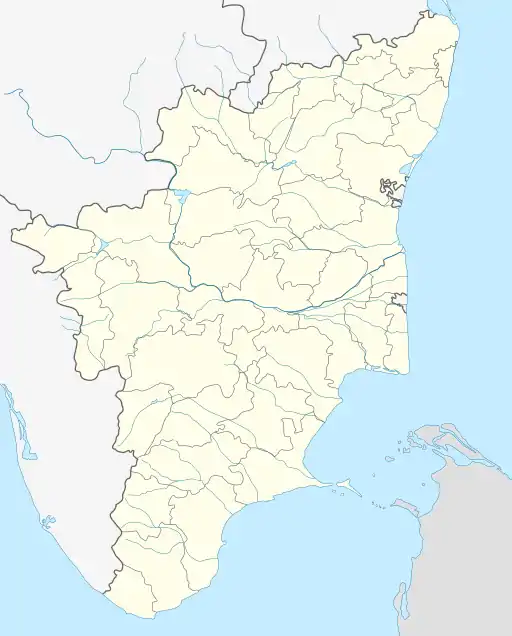Thirumanikkoodam
Thirumanikkoodam or Varadaraja Perumal Temple is located in Thirunangur, a village in the outskirts of Sirkazhi in the South Indian state of Tamil Nadu, is dedicated to the Hindu god Vishnu. Constructed in the Dravidian style of architecture, the temple is glorified in the Divya Prabandha, the early medieval Tamil canon of the Azhwar saints from the 6th–9th centuries AD. It is one of the 108 Divyadesam dedicated to Vishnu, who is worshipped as Varadharaja Perumal.
| Thirumanikkoodam | |
|---|---|
 | |
| Religion | |
| Affiliation | Hinduism |
| District | Mayiladuthurai |
| Deity | Varadaraja Perumal, Senkanmal (Vishnu) Thirumamagal, Bhoodevi (Lakshmi) |
| Features |
|
| Location | |
| Location | Thirunangur |
| State | Tamil Nadu |
| Country | India |
 Location in Tamil Nadu | |
| Geographic coordinates | 11°10′46″N 79°47′17″E |
| Architecture | |
| Type | Dravidian architecture |
It is one among the eleven divyadesams of Thirunangur Tirupathis and is closely associated with Thirumangai Alvar. It is also the only temple in the Nangur divyadesams to have revered by an azhwar other than Thirumangai Alvar. As per Hindu legend, the temple tank for dug by Arjuna from the age of Mahabaratha. Krishna appeared as Parthasarathy to Arjuna here and initiated his education, leading to the name of the temple.
The temple is open from 8 a.m. to 10 a.m. and 5 p.m. to 7 p.m and has four daily rituals at various times of the day. The Thirumangai Azhwar Mangalasasana Utsavam celebrated annually during the Tamil month of Thai is the major festival of the temple during which the festival images of the eleven Thirunangur Tirupathis are brought on mount designed like Garuda, called Garuda Vahana, to Thirunangur. The temple follows thenkalai mode of worship.
Legend
The legend of all the eleven temples of Thirunangur are closely associated with each other. As per legend, the Hindu god Shiva started dancing in fury at this place after the death of his consort Uma due to the yagna (sacrifice) of Daksha. Each time his lock of hair touched the ground, there were eleven other forms of Shiva who appeared. The celestial deities were worried that if the dance continues, it would result in decimation of entire creations. They prayed to Vishnu for help, who appeared at this place. On seeing Vishnu, Shiva's anger was reduced and he requested Vishnu to appear in eleven forms like he did. On his request, Vishnu appeared in eleven different forms at Tirunangur. The eleven places where Vishnu appeared are believed to be where the eleven temples in Tirunangur are located.[1]
The Temple
The temple complex has a single prakaram(outer courtyard) and a single shrine. It is located close to Thirunangur, a small village, 8 km east of Sirkali en route to Thiruvenkadu. Eleven Rudras and the king of celestial deities, Devas, are believed to have worshipped Varadarajar.[2] The presiding deity, Varadharajaperumal is housed in the santum in standing posture, facing east. The images of his consort, Sreedevi (also called Thirumaamagal Nachiyar) and Bhoodevi are housed in the same shrine.[3]
Festival

The temple is open from 8 a.m. to 10 a.m. and 5 p.m. to 7 p.m. The temple priests perform the pooja (rituals) during festivals and on a daily basis. As at other Vishnu temples of Tamil Nadu, the priests belong to the Vaishnavaite community, a Brahmin sub-caste. The temple rituals are performed four times a day: Ushathkalam at 8 a.m., Kalasanthi at 10:00 a.m., Sayarakshai at 5:00 p.m. and Ardha Jamam at 7:00 p.m. Each ritual has three steps: alangaram (decoration), neivethanam (food offering) and deepa aradanai (waving of lamps) for both Pallikonda Perumal and Shenbagalavalli. During the worship, religious instructions in the Vedas (sacred text) are recited by priests, and worshippers prostrate themselves in front of the temple mast. There are weekly, monthly and fortnightly rituals performed in the temple.[4]
The annual Theerthavari festival is celebrated during the New moon day of Tamil month of Aadi when the festival deity of the temple is taken in a procession to the sea at Poompuhar. During the new moon day of the Tamil month Thai, the festival deity of Thirumangai Azhwar is brought to the temple from Thiruvali-Thirunagari.[5] The Thirumangai Azhwar Mangalasasana Utsavam is celebrated in the Tamil month of Thai (January–February). The highlight of the festival is Garudasevai, an event in which the festival images of the eleven Thirunangur Tirupathis are brought on mount designed like Garuda, called Garuda Vahana, to Thirunangur. The festive image of Thirumangai Azhwar is also brought on a Hamsa Vahanam (palanquin) and his paasurams (verses) dedicated to each of these eleven temples are recited during the occasion. The festival images of Thirumangai Alvar and his consort Kumudavalli Naachiyar are taken in a palanquin to each of the eleven temples. The verses dedicated to each of the eleven temples are chanted in the respective shrines. This is one of the most important festivals in the region which draws thousands of visitors.[5][6]
Religious significance
The temple is revered in Nalayira Divya Prabhandam, the 7th–9th century Vaishnava canon, by Periazhwar, Thirumalisai Alvar and Thirumangai Azhwar. The temple is classified as a Divyadesam, one of the 108 Vishnu temples that are mentioned in the book. During the 18th and 19th centuries, the temple finds mention in several works like 108 Tirupathi Anthathi by Divya Kavi Pillai Perumal Aiyangar.[4]
Notes
- R. 2001, pp. 470-1
- Ayyar 1993, p. 535
- Anantharaman, Ambujam (2006). Temples of South India. East West Books (Madras). pp. 62–67. ISBN 978-81-88661-42-8.
- "Sri Senganmal Ranganathar temple". Dinamalar. 2014. Retrieved 31 May 2014.
- S., Prabhu (12 July 2012). "Shrine dedicated to Arjuna". The Hindu. Retrieved 9 September 2013.
- "Garuda Sevai" (PDF). Ramanuja.org. Retrieved 19 August 2011.
References
- Ayyar, P. V. Jagadisa (1993). South Indian shrines: illustrated (2 ed.). New Delhi: Asian Educational Services. ISBN 81-206-0151-3.